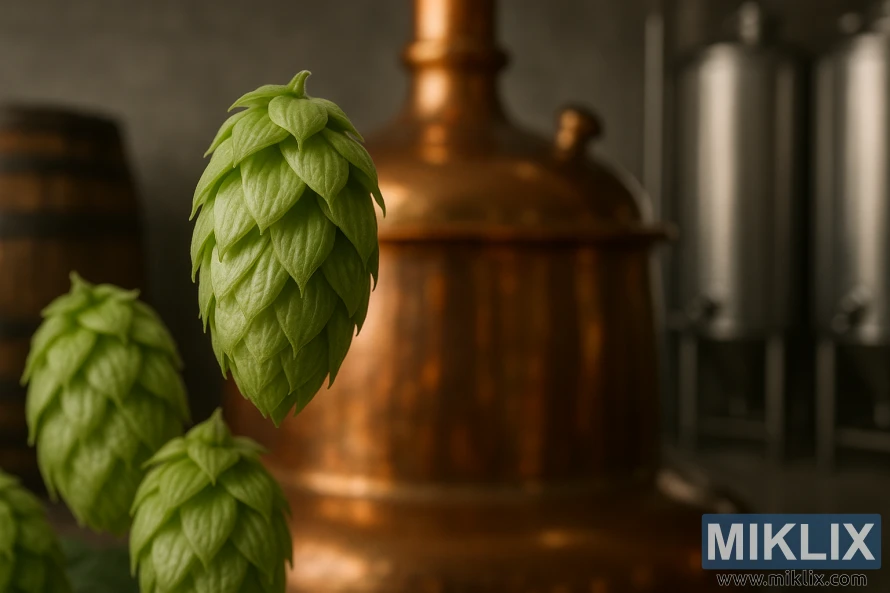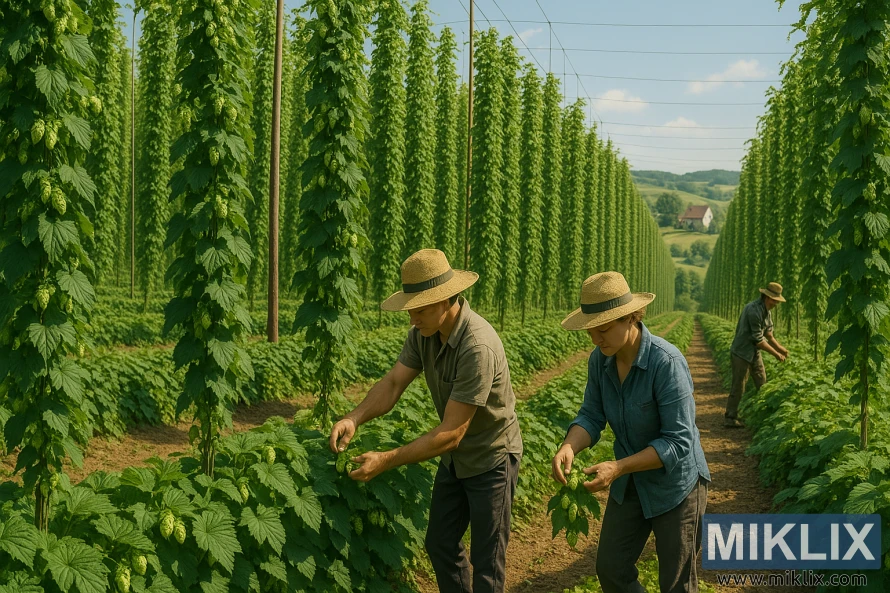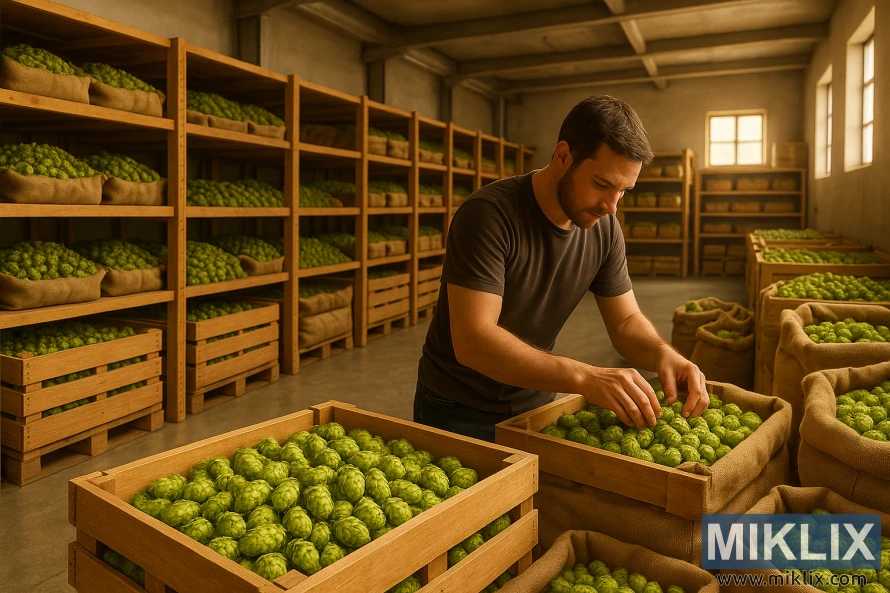Hops in Beer Brewing: Tettnanger
Published: August 7, 2025 at 10:55:08 AM UTC
Tettnanger is a noble hop variety celebrated for its delicate and well-balanced flavor. It's a cornerstone in traditional European beer brewing. With a rich history, Tettnanger boasts mild floral notes. It's perfect for brewing lagers and pilsners, adding a subtle character to these beer styles. The use of Tettnanger in beer brewing showcases its versatility and value. It's essential for crafting balanced and refined beers.

Key Takeaways
- Tettnanger is a noble hop variety used in traditional European beer brewing.
- It is known for its delicate and well-balanced flavor profile.
- Ideal for brewing lagers and pilsners, adding subtle character.
- Tettnanger lends itself to creating balanced and refined beers.
- A versatile hop variety valued for its mild floral notes.
Understanding Tettnanger Hops: Origins and History
Tettnanger hops hail from the Tettnang region, a cornerstone in beer brewing. Their history stretches back to the 19th century, rooted in the landrace hop varieties of the area. This heritage makes them a key player in the brewing world.
These hops share a lineage with English Fuggle hops, exhibiting similarities in their traits. Grasping their origins and history is vital for appreciating their distinct qualities and roles in brewing.
The roots of Tettnanger hops are deeply embedded in Southern Germany's brewing traditions. Here are some essential facts about their origins and history:
- Tettnanger hops are named after the Tettnang region in Southern Germany.
- They are one of the four noble hop varieties, alongside Hallertau, Saaz, and Spalt.
- Tettnanger hops have been cultivated for over a century.
- They are closely related to English Fuggle hops.
The importance of Tettnanger hops in brewing is evident in their unique flavor and aroma. They offer a mild, slightly spicy, and floral taste. This makes them perfect for various beer styles, where a subtle hop presence is desired.
Chemical Composition and Characteristics
Understanding Tettnanger hops' chemical makeup is key to unlocking their full brewing value. These hops are known for their low alpha acid content, typically between 3-6%. This characteristic makes them perfect for crafting beers that need a delicate bitterness and a strong aroma.
The hop resins in Tettnanger hops are vital for their brewing prowess. These resins are the source of beer's bitterness and flavor. With a balanced profile, Tettnanger hops are adaptable, fitting into a wide range of beer styles.
Tettnanger hops also boast a complex mix of essential oils, essential for the beer's aroma. The harmony between alpha acids and essential oils in Tettnanger hops makes them a favorite among brewers. They aim to create beers with a refined and subtle hop character.
- Tettnanger hops have a low alpha acid content, making them suitable for beers requiring subtle bitterness.
- The hop resins in Tettnanger hops contribute to their bitterness and flavor compounds.
- The essential oils in Tettnanger hops play a critical role in the beer's aroma profile.

The Distinctive Aroma Profile of Tettnanger Hops
Tettnanger hops are celebrated for their unique aroma, blending floral, spicy, and pepper notes. This blend makes them a top choice among brewers. Their mild floral and spicy nuances offer a balanced aroma, enriching beers with a distinct character.
The aroma profile of Tettnanger hops is highly valued. It features black tea, floral, herbal, pepper, and spicy flavors. These elements enhance the complexity and depth of various beer styles. Grasping the aroma profile is key to picking the right hop variety for different beer styles.
- Tettnanger hops provide a balanced aroma, neither too strong nor too weak.
- The floral notes in Tettnanger hops complement a wide range of beer styles, from lagers to ales.
- The spicy and pepper notes add a unique twist to beers, making Tettnanger hops a versatile choice for brewers.
By using Tettnanger hops in their brewing, brewers can craft beers with a standout aroma. Whether brewing a traditional German lager or an experimental ale, Tettnanger hops can bring the complexity and depth desired.
Growing and Harvesting Tettnanger Hops
Growing Tettnanger hops requires meticulous care and a suitable climate. These hops thrive in temperate climates with moderate rainfall. Regions with mild winters and cool summers are perfect for their cultivation.
Cultivating Tettnanger hops demands attention to soil quality, climate, and pest management. Farmers must ensure the soil is nutrient-rich and well-drained. Regular checks for pests and diseases are essential to protect the hop cones.
Harvesting Tettnanger hops usually happens in the fall. The hops are ready when the cones are fully formed and have a papery texture. The timing of the harvest is critical for maintaining the quality and flavor of the hops.
- Key factors in Tettnanger hop cultivation include soil quality, climate, and pest management.
- Regular monitoring and maintenance are necessary to ensure a healthy crop.
- The harvesting process requires precision to capture the hops at their peak quality.

Best Beer Styles for Tettnanger Hops
Tettnanger hops are a versatile ingredient in beer brewing, perfect for traditional European lager styles. Their unique balance of bitterness and aroma makes them an excellent choice for brewers. They aim to create authentic lagers and pilsners.
Tettnanger hops are ideal for brewing European lagers. Their subtle bitterness and pronounced aroma can shine in these styles. They are also well-suited for pilsner brewing, adding a crisp, clean flavor profile. This is characteristic of traditional pilsners. Plus, Tettnanger hops pair well with Belgian and German wheat beers. They add a unique dimension to these styles.
- European lagers, such as German Pilsner and Czech Lager
- Pilsners, where Tettnanger hops add a delicate hop flavor
- Belgian and German wheat beers, which benefit from the unique aroma profile of Tettnanger hops
By incorporating Tettnanger hops into these beer styles, brewers can create complex and balanced flavor profiles. These showcase the unique characteristics of this hop variety.
Brewing Techniques with Tettnanger Hops
Using Tettnanger hops in brewing can greatly improve a beer's flavor and aroma. These hops are versatile, fitting into various brewing stages, from bittering to dry hopping.
Tettnanger hops are celebrated for their floral and spicy notes. This makes them perfect for brewers aiming to deepen their beer's character. Experimenting with different hop addition times can help brewers achieve the perfect flavor.
Tettnanger hops are versatile, complementing a wide range of beer styles. They can elevate both traditional German lagers and American-style ales, adding a unique twist to the brewing process.
- Tettnanger hops are great for bittering, adding a subtle spice flavor.
- They're also excellent for flavor and aroma additions, bringing floral and spicy notes.
- Dry hopping with Tettnanger hops can create a beer with a complex, intriguing aroma.
When brewing with Tettnanger hops, consider their alpha acid content. This affects the beer's bitterness. Tettnanger hops have a moderate alpha acid level, fitting various beer styles.
To fully utilize Tettnanger hops, brewers should explore different brewing techniques and hop addition strategies. This might involve adjusting hop addition timing or blending Tettnanger with other hops for a unique flavor.
Understanding Tettnanger hops and their role in brewing opens up new avenues for creating complex, flavorful beers.
Optimal Timing for Hop Additions
To achieve the desired flavor and aroma, brewers must carefully consider the timing of Tettnanger hop additions. The optimal timing for hop additions depends on the desired flavor and aroma profile.
Tettnanger hops can be added at various stages of the brewing process, from bittering to dry hopping. Each stage contributes to the overall character of the beer. For bittering, hops are typically added early in the boil, around 60 minutes before the end.
- Early boil additions (60-45 minutes) are used for bittering.
- Mid-boil additions (15-30 minutes) contribute to flavor and aroma.
- Late boil additions (5-10 minutes) or flameout enhance the beer's aroma.
- Dry hopping, which occurs after fermentation, adds complex hop flavors without bitterness.
Understanding the role of each hop addition stage is key for brewers to achieve their desired beer profile. By adjusting the timing of Tettnanger hop additions, brewers can balance bitterness, flavor, and aroma. This creates a well-rounded beer.
Storage and Preservation Methods
Maintaining the quality of Tettnanger hops relies heavily on the storage and preservation methods used. These hops' unique traits can be preserved with careful handling and storage techniques.
Cooling is a critical step in the storage process. Tettnanger hops need to be stored in a cool environment. This slows down the degradation process, preserving their aroma and flavor.
Packaging is also key. Hops should be packaged in airtight containers or bags. This prevents exposure to air, moisture, and light, maintaining their quality and potency.
Several best practices exist for storing and preserving Tettnanger hops:
- Store hops in a cold environment, ideally at temperatures below freezing.
- Use airtight containers or bags to prevent exposure to air and moisture.
- Keep hops away from direct light, as it can cause degradation.
- Monitor the storage conditions regularly to ensure optimal preservation.
By adhering to these storage and preservation methods, brewers can ensure their Tettnanger hops retain their unique characteristics. This contributes to the production of high-quality beers.

Common Brewing Challenges and Solutions
Working with Tettnanger hops presents several challenges for brewers. One major hurdle is achieving the perfect balance of flavor and aroma. These hops have a delicate profile that can be easily overshadowed by other ingredients or brewing methods.
To overcome this, brewers can tweak their techniques. For example, adding Tettnanger hops later in the brewing process helps preserve their aroma. It's also important to balance the hops with other ingredients to avoid overpowering the beer's overall flavor.
Managing hop-related issues is another critical aspect of brewing with Tettnanger hops. This includes preventing contamination or spoilage, which can ruin the beer's quality. Proper storage and handling of the hops are key to maintaining their quality.
Some common hop-related issues and their solutions include:
- Contamination: Ensure all equipment is sanitized, and hops are stored in a clean, dry environment.
- Spoilage: Store hops in airtight containers, away from light and heat, to preserve their flavor and aroma.
- Overuse: Be cautious of the amount of hops added to avoid bitterness or flavor imbalance.
By understanding these challenges and implementing the right solutions, brewers can optimize their use of Tettnanger hops. This leads to creating high-quality beers that highlight the unique characteristics of this hop variety.
Pairing Tettnanger with Other Hop Varieties
Tettnanger hops are incredibly versatile, making them perfect for blending with other varieties. This combination allows brewers to craft beers with complex and intriguing flavor profiles.
These hops can be paired with a wide range of hop types. From traditional noble hops like Saaz and Hallertau to newer, more experimental varieties. Each blend brings a unique character to the beer, enabling brewers to explore various flavors and aromas.
When blending Tettnanger with other hops, brewers must consider several factors. The alpha acid content, flavor, and aroma of each hop variety are key. For instance, pairing Tettnanger with high-alpha-acid hops like Chinook can introduce bitterness and depth. On the other hand, combining it with citrusy hops like Citra can enhance the beer's aroma.
- Popular pairings include Tettnanger with Saaz for a traditional European-style lager.
- Tettnanger with Cascade for a balanced ale with floral notes.
- Tettnanger with Mosaic for a complex IPA with fruity and spicy flavors.
Understanding how to blend hops effectively is essential for brewers. It allows them to achieve the desired aroma and flavor in their beers. By experimenting with different hop pairings, brewers can create unique and delicious beers that highlight Tettnanger's characteristics.
Commercial Brewing Applications
In the world of commercial brewing, Tettnanger hops stand out for their versatility and distinct traits. They are a key ingredient in many breweries, from small craft operations to large industrial producers.
Tettnanger hops are prized for their unique flavor and aroma, which elevate the quality of various beer styles. Their special properties make them a top choice for brewers aiming to create distinctive beers that capture market attention.
- Enhancing the flavor and aroma of traditional German beer styles
- Adding complexity to pale ales and IPAs
- Providing a unique character to lagers and bocks
Using Tettnanger hops in large-scale brewing demands meticulous planning and execution. Breweries must consider hop storage, handling, and addition timing to achieve the best results.
By grasping the commercial applications of Tettnanger hops, brewers can craft high-quality, unique beers on a large scale. This meets the competitive demands of the market.
Recipe Development Guidelines
Creating recipes that highlight Tettnanger hops requires grasping their role in the beer's taste and aroma. These hops are celebrated for their floral and spicy notes, which enrich various beer styles with depth and complexity.
In crafting beer recipes with Tettnanger hops, brewers must consider the hop's alpha acid content and its interaction with other ingredients. With a moderate alpha acid level, Tettnanger hops are versatile for a broad spectrum of brewing applications.
To effectively incorporate Tettnanger hops into beer recipes, brewers can follow these guidelines:
- Select complementary ingredients that enhance the hop's floral and spicy notes.
- Consider the brewing technique, as Tettnanger hops can be used for both bittering and aroma additions.
- Experiment with different hop varieties to create unique flavor profiles.
Popular beer recipes that feature Tettnanger hops include traditional German lagers and pale ales. These styles showcase the hop's versatility and its ability to contribute to a balanced flavor profile.
In recipe development, balancing hop varieties is also key. Tettnanger hops pair well with other noble hop varieties to create complex and nuanced beers. For example, combining Tettnanger with Hallertau or Saaz hops can yield a rich, aromatic flavor profile.
By understanding Tettnanger hops' characteristics and applying these recipe development guidelines, brewers can craft unique and delicious beers. These beers will showcase the qualities of this versatile hop variety.
Conclusion: Mastering Tettnanger Hops in Your Brewing Process
Mastering Tettnanger hops in beer brewing demands a deep understanding of their unique traits, brewing techniques, and applications. By comprehending the origins, characteristics, and brewing methods of Tettnanger hops, brewers can unlock their full capacity. This enables them to create exceptional beers.
The brewing process can be elevated by incorporating Tettnanger hops. They are well-suited for traditional European lagers and other beer styles. As the craft of beer brewing evolves, the role of Tettnanger hops and other noble hop varieties will remain vital. They are essential for creating distinctive, high-quality beers.
Looking to future directions in brewing, Tettnanger hops' versatility will continue to inspire brewers to experiment and innovate. By mastering Tettnanger hops, brewers can stay at the forefront of brewing excellence. They can produce beers that showcase the unique qualities of these noble hops.
Further Reading
If you enjoyed this post, you may also like these suggestions:
